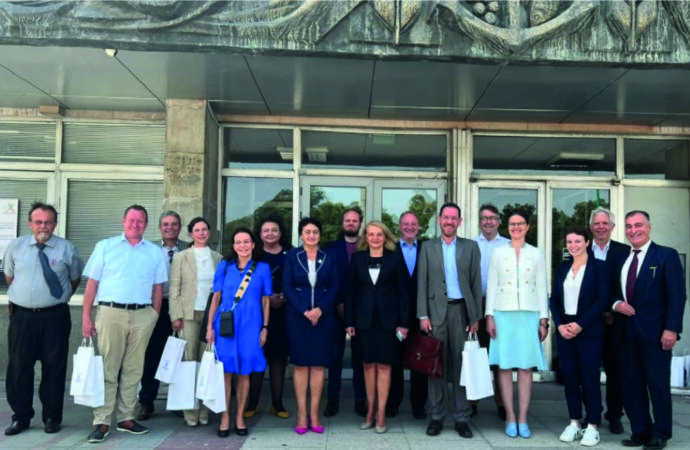The semiconductor crisis at the beginning of 2020 and its impact on the automotive industry have made it clear: global supply and value chains are more crisis-prone than expected. What began with the COVID 19 pandemic was fuelled once again by the war in Ukraine – supply chains do not function reliably, trade routes at
The semiconductor crisis at the beginning of 2020 and its impact on the automotive industry have made it clear: global supply and value chains are more crisis-prone than expected.
What began with the COVID 19 pandemic was fuelled once again by the war in Ukraine – supply chains do not function reliably, trade routes at the beginning of the value chain are interrupted, companies can no longer produce and at the same time large markets are lost due to economic sanctions. Further disruptions and crises are also to be expected due to climate change. In order to be able to cope with these problems, competitive companies, diversified supply chains, digital tools and thus overall more resilience are needed – also in the region around the Danube.
Small and medium-sized enterprises (SMEs) in the Danube Region are particularly dependent on forming new value chains in order to remain competitive in the future. The recent crises have revealed clear weaknesses. New approaches and tools are needed to make value chains more efficient, resilient and sustainable. However, companies across the Danube Region lack knowledge on how to readjust their value chain management and find the right partners for sustainable value chains. Both suppliers (mostly SMEs) and buyers need targeted support to ensure crisis-proof value chains. This results not only in new requirements for value chains, but also in an urgent need for additional support for the development of these very chains.
The new understanding of value chain development
In order to reduce the impact of disruptions of any kind as effectively as possible in times of crisis, a robust and adaptable value chain network is necessary. To enable such a network for different use cases, the Danube Alliance was launched at the beginning of 2021 as a flagship project of Priority Area 8 of the EU Strategy for the Danube Region. The overarching goal of the project, which will run until the end of 2022, was to promote the resilience of existing and new transnational supply chains in the Danube Region, namely to support small and medium-sized enterprises in embedding themselves in new value chains and to contribute to making the Danube Region more competitive. Ultimately, the project was able to make an important contribution to reducing dependencies on non-European suppliers and stabilising fragile elements of a value chain.
The project also became a success through its first use case: the Danube Alliance selected Miscanthus (also known as elephant grass) for the analysis and modelling of a robust value chain. Originally from Asia, the species Miscanthus x gigantheus has multiple uses that could make the plant an important resource for the bioeconomy in Europe. In addition to its use as a fuel, miscanthus can also be used to build a biogenic circular economy. Following this example, the project was able to achieve a multi-method approach comprising three main steps: 1. identify & understand, 2. analyse & simulate, and 3. act & implement. For the latter, the Danube Alliance consortium went on a trip to Sofia and Vidin in Bulgaria in September 2022 to meet with regional stakeholders for the Miscanthus pilot project. The focus of this meeting was on regional needs, joint research of appropriate areas for Miscanthus use and a possible implementation strategy. For this purpose, the delegation held nu- merous discussions with various local authorities. “I was pleasantly surprised by the great interest in Vidin in our proposals to use biomass for renewable energy production and the willingness to cooperate,” remarks Carmen Hawkins, Priority Area 8 Coordinator for the Danube Region. Now it is important to turn words into deeds and develop something concrete.
Until its project completion, the Danube Alliance focused on understanding, analysing and promoting resilience in selected (bioeconomic) value chains to support the inclusion of SMEs in more sustainable and resilient value chains.
The Danube Alliance Network – the next project phase
The Danube Alliance was also able to establish itself in the first project phase as a platform that supports the formation of tailor-made partnerships and consortia for further (cross-regional) projects related to the development of resilient value chains and identifies suitable funding opportunities for project initiation. The approaches of the Danube Alliance and the Value Chain Gene- rator tool introduced in this phase – a software to identify the most suitable trade links – are still new and need to be further developed. Likewise, the development of a living network with selected partners from the Danube region is still in its infancy. This is precisely where the next phase of the project, which is scheduled to run until 2027, comes into play: the development of the Danube Alliance Network. This network is intended to help connect more partners from the Danube region and jointly develop and strengthen sustainable value chains with a focus on the circular bioeconomy.
Danube Alliance
Project consortium: VDI-VDE-IT GmbH, BioPro, University Reutlingen, Steinbeis Europa Zentrum
Jennifer Ohnmacht,
VDI/VDE Innovation + Technik GmbH
Energy from plants? It depends!
Should maize be on the table or in the tank, providing food or energy? Baden-Württemberg rejects the large-scale cultivation of maize for energy production for ecological reasons.
In Bulgaria, what is currently still burned in the fields goes into the tank: Residual materials such as wheat stalks, corn stalks or leaves.
The miscanthus project in the Widin district goes one step further. There, the cultivation of food crops on 25,000 hectares of land is not worthwhile due to the quality of the soil. Instead, miscanthus is to be cultivated on this so-called marginal land for energy production. In the long term, the plant also improves soil quality.



















